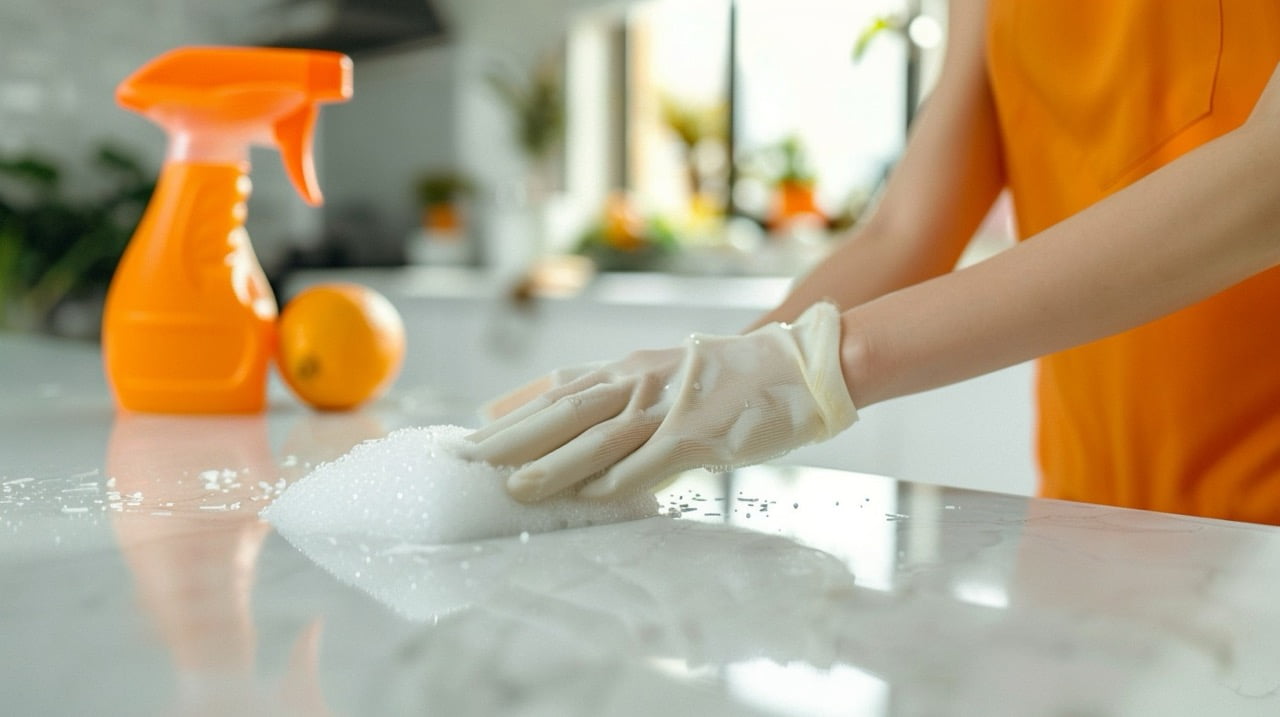The dirty bathroom sink is glaring at you. Then you notice watermarks on the mirror, too. Oh, and the floor could use a good mopping…
It feels as if you just did all of this and yet you have to clean house again. You can think of ten other things you’d rather be doing than donning your rubber gloves to hunch over a dirty toilet bowl.
Yup, cleaning your home can often feel like an overwhelming, annoying and utterly boring chore, especially when you’re trying to balance it with other responsibilities. Wouldn’t it be great if you could at least clean fast?
Table of Contents
Working Against the Clock
Long before I put myself through graduate school and eventually landed in tech, I had worked as a chambermaid. Anyone who’s done similar work knows it’s fast-paced labour where you really have to keep your eye on the clock.

These pros only have so and so many minutes to get a good deep clean done in record time, and it has to be tip-top because it’s usually going to get inspected. In hotels, for example, the head of housekeeping will come do her walkabout before she green-lights a finished room for reception to assign to new guests incoming.
So how do housekeepers clean so fast then? And can their strategies be applied in your own home? Get ready to break out your scrubber, dust rag, toilet brush and spray bottles. Here are a few things the pros do in their speed-cleaning process, which can work great in your household, too.
Cleaning Secrets 101 or: First Things First If You Want a Clean Home Fast
Taking a strategic approach is going to be your biggest time saver. If cutting your cleaning time in half is your aim, being methodical is the fastest route to tidy town.
I mean, we’ve all been there: you start wiping something down in the bathroom, then remember you need to start the load of towels, then you take the empty bottle of detergent to the kitchen and by the time you’ve tossed it in the recycling bin and noticed yesterday’s mail is still lying unopened on the countertop, you forgot what you were originally doing. 😅
You’re not getting senile. You just need to tackle the cleaning job at hand in a more organised fashion. So don’t waste time. Numero uno: pick a room and stay put. Start with a blitz tidy-up.
PICK A ROOM
Focus on one room or area at a time and start with a blitz tidy up.
You can’t clean around a bunch of stuff on the floor. You can’t wipe the countertops down properly if last week’s junk mail is still piled up on them. Get that stuff cleared out so you can clean.
So pick an area you want to focus on when you start cleaning, and pick things up first. Once you’ve tidied a bit, you can turn your attention to removing dust, dirt, and grime from all surfaces.
Wait, you say, where do you start when the whole place needs cleaning?
Fast and effective cleaning means prioritising tasks based on the level of dirtiness and the function of each room. Professional cleaners therefore tend to focus first on high-traffic areas such as kitchens and bathrooms because they typically require a more detailed cleaning compared to other areas.
30-MIN SPEED CLEANING PLAN
In a jam because unexpected guests are on the way over? Before you hit the red alert, check out my guide to doing a 30-minute speed cleaning.
When I was a maid, I was taught to do all the tidying first. In a hotel that equates to waste and laundry removal. Once I cleared all of that out, I began with the actual cleaning process in the bath. To this day, I still always start my personal cleaning sessions in the bath and kitchen before I move on to other rooms. Good routines stick!
But How Do Housekeepers Clean So Fast? Trick of the Trade: It’s All in the Flow
Professional housekeepers obviously have a routine down pat, and they know their stuff because they’ve seen it all. But we’re not talking about different use cases for bleach or windex or white vinegar here. It’s far simpler:
They tend to walk into a room and are able to identify the most effective cleaning path through a space, so that no movement is wasted. There’s just far less back and forth to retrieve items – also because they have all the necessary tools and cleaning products ready to go in a caddy or cart. This means they can seamlessly transition from one cleaning task to the next.
Let’s circle back to their systematic approach to tackling each room though. This plays a big role in answering the question of how do housekeepers clean so fast.
Quick Housekeeping Hacks That Work Top to Bottom
Cleaning services typically work in a top-to-bottom fashion, and this was also the case for me when I was a maid.
If you start at the top and work your way down to the floor, any dislodged dust and debris will be captured as you make your way through the cleaning process. That means it’ll ultimately land on the floor where it can be hoovered or mopped up at the end of your session.
TAKE IT FROM THE TOP
Avoid messing up what you already cleaned by working from top to bottom.
If you were to dust down everything on your chest of drawers first and then do the mirror hanging above it, well, the dust from the latter is going to land back on the surface you just cleaned. Start from the top. When there’s no need for re-cleaning any surfaces, you save time.
Cleaning experts also generally break down the cleaning process into manageable steps. In private residences for instance, they might clean all the bathrooms in one go to streamline their efforts, letting an anti-scale cleanser work its magic on fixtures while they scrub the tub, before pivoting to wipe and rinse the shower stall. Then they might switch up their utensils and move on to a different task in a left-to-right fashion, but they’re still usually focused on one room at a time.
Speaking of Dust
Keeping dust at bay not only makes your place sparkle, but it also promotes better indoor air quality. Over time, dust accumulates on surfaces, and without regular removal, it can circulate through your home’s air, potentially exacerbating allergies and even respiratory issues.
I like to use microfibre cloths for dusting because they trap dust particles quite well, rather than merely dispersing them. I do use an ostrich feather duster though for delicate things like artwork and fragile tchotchkes.
Another nice side effect of dusting with cleaning cloths is that it kind of forces you to inspect your stuff at the same time, helping to maintain a clean and organised home. That just makes it easier to spot any problems early on, such as nicks and scratches or, even worse, things like mould and pests.
House Cleaning from Left to Right, Huh?
Parallel to the top-to-bottom cleaning strategy, pro cleaners adopt a left-to-right cleaning strategy ensures that no surface is missed and that the cleaning process is as efficient as possible.
DO A CLEAN SWEEP
By working each room in a clockwise fashion, you’ll be sure to cover everything.
This systematic approach not only guarantees thorough coverage but also streamlines the cleaning process. By setting a clear path for cleaning, you minimise the chances of overlooking areas and reduce the need to clean already cleaned surfaces.
This methodical approach commonly used by professional cleaners can also be applied to the organisation of your cleaning tasks. By completing everything that requires a particular tool or product before moving on to the next set of tasks, you minimise setup time and build speed.
Select the Proper Tools for Each Cleaning Task
I’d be remiss if I didn’t mention that having a few proper cleaning tools is crucial for achieving a clean home without causing damage to surfaces.

A few of the aforementioned high-quality microfiber cloths, for example, are essential for dusting and cleaning surfaces without leaving scratches or lint behind.
KNOW YOUR TOOLS
Use the right tools and keep them corralled together to save time.
For floors, choosing the right vacuum cleaner with appropriate attachments can make a significant difference in removing dirt from carpets, baseboards, and hard floors efficiently. Meanwhile, sponges and scrub brushes should be chosen based on the surface being cleaned to avoid abrasion while ensuring thorough cleaning.
If you’re new to all this stuff – maybe you just moved into your very first apartment – keep in mind that you don’t want to be mixing up “clean” tools with “dirty” equipment.
Keep the sponges and scrub brushes you use in the bathroom separate from the rags you use for dusting your tables, for example. Never use a bathroom sponge in the kitchen. You do not want to be spreading anything unsavoury around.
Keeping a dedicated caddy for your bath’s cleaning utensils or just stowing them beneath the bathroom vanity helps keep them separate from your other cleaning tools.
Establish an Effective Routine You Can Stick With
At the end of the day, if you create an effective cleaning routine that works for you and your timeframe, it will make it easier in the long-term to manage your cleaning time more efficiently.
DO WHAT WORKS FOR YOU
Settle into a cleaning routine that works for you, not against you.
If you have a lot on your plate because you’re all alone or have little kids, then setting a regular cleaning schedule just like a professional cleaning company would is extremely helpful. One glance at your planner or to-do list and you’ll know what light daily tasks are slated for which days, and when you have more intensive weekly cleanings penciled in.
Daily tasks might include wiping down kitchen surfaces with cleaning cloths, doing dishes, and tidying up living areas, which can prevent clutter and dirt from accumulating and thus help keep a clean home.
Weekly tasks could involve more thorough cleanings, such as dusting, vacuuming, and bathroom cleaning, to keep your home in top condition. These are all details that are really going to come down to your personal living situation and, of course, the size of the space you want to keep clean.
I’ve previously shared my own weekly cleaning schedule for a solo household, and it really does help keep me on my toes. Plus, I always know when I have more elaborate seasonal deep-cleaning sessions on the horizon. You know, those annoying but must-do tasks like cleaning behind appliances, washing windows, and clearing out gutters.
Whatever your case may be, working in a strategic manner from top to bottom and left to right can definitely help you clean your house faster. And by establishing a routine that suits your situation and lifestyle (and making it a habit!), you can pretty much maintain a consistently clean and organised home.
Look at you, you’re a cleaning pro!
Key Cleaning Takeaways
- Do a fast tidy-up before starting the actual cleaning.
- Begin cleaning from the top down to avoid re-cleaning surfaces.
- Use the right tools and products for efficient and effective cleaning, and keep them together.
- Cleaning services often implement a left-to-right cleaning strategy to ensure thorough coverage, and so can you. It’s a great way to clean more quickly and efficiently.
- Get into the habit of a consistent cleaning routine to keep your home clean and organised.


































Leave a Reply